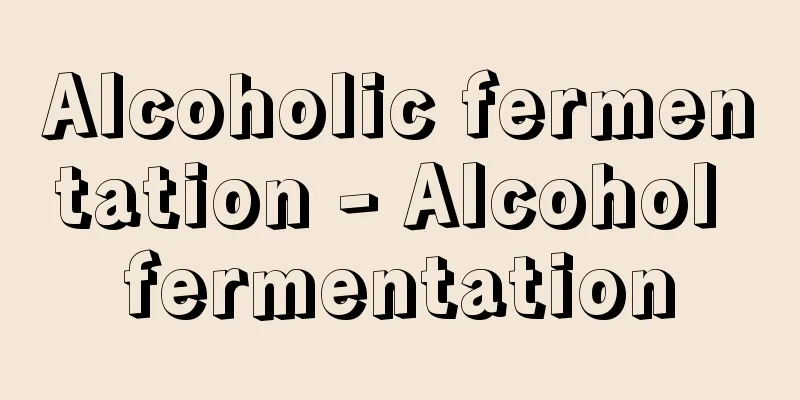Alcoholic fermentation - Alcohol fermentation

|
A type of anaerobic decomposition (fermentation) of carbohydrates by microorganisms. It is also called alcoholic fermentation, and is one of the most representative fermentations along with lactic acid fermentation. It is a reaction that ultimately produces ethyl alcohol (ethanol) and carbon dioxide (carbon dioxide gas) from sugars or polysaccharides, and is shown in the following formula. C 6 H 12 O 6 ―→2CH 3 CH 2 OH+2CO 2 [Ito Seiga] Research HistoryAlcoholic fermentation is a natural phenomenon that humans have used since prehistoric times to produce alcoholic beverages and bread, but its cause remained unknown, and even in the 19th century, the lees (yeast) that are generated when making beer were thought to be merely chemical substances. However, between 1857 and 1858, French microbiologist Pasteur discovered that fermentation occurs due to microorganisms. Then, in 1897, German biochemist Büchner discovered that fermentation occurs in cell-free yeast extracts, and named the substance, or enzyme, responsible for fermentation zymase. Furthermore, A. Harden (1865-1940) and W. J. Young (1878-1942) discovered that inorganic phosphoric acid is required for alcoholic fermentation to continue using yeast juice, and discovered that sugar phosphate esters are produced and that coenzymes are present in the ultrafiltrate of yeast juice. Furthermore, as research into the fermentation process progressed, German-born American biochemist Carl Neuberg (1877-1956) and others discovered that alcoholic fermentation and glycolysis of glycogen in muscle extracts follow very similar pathways. In addition to Neuberg, many other researchers, including German physiological chemist Meyerhof and German biochemist Emden, as well as J. K. Parnas (1884-1949) and O. H. Warburg, devoted their efforts to elucidating the fermentation and glycolysis processes, and the decomposition pathway is named after them as the "Emden-Meyerhof-Parnas pathway." [Ito Seiga] Fermentation processTo summarize the process of alcoholic fermentation, carbohydrates are phosphorylated by ATP (adenosine triphosphate) to form hexose diphosphate, which then produces two molecules of triose phosphate. This is then oxidized to produce two molecules of ATP and becomes pyruvic acid. Pyruvate is decarboxylated to an aldehyde, which is then reduced to finally produce alcohol. In terms of the energy balance during the fermentation process, four molecules of ATP are produced, but two molecules of ATP are used in the initial phosphorylation of the carbohydrate, so in the end, two new molecules of ATP are obtained per fermented glucose molecule, and organisms use this acquired energy to synthesize the substances they need to sustain themselves, grow, and reproduce. Some bacteria ferment sugars in ways other than alcoholic fermentation, and various fermentation methods are known, such as lactic acid fermentation and acetic acid fermentation. Since around 1980, a method of producing alcohol using microbial activity from renewable plant resources (biomass), such as rice straw, wheat straw, bagasse (sugarcane residue), and waste wood, has been attracting attention as a way of reproducing energy. [Ito Seiga] "Ethanol Industry" by Kusano Akihisa (1983, Fermentation Industry Association)" ▽ "Illustrated Biotechnology 2: From Brewing and Fermentation to Reactors - The Practical Use of Microorganisms and Enzymes" edited by Ochi Takeo (1989, Agricultural Books)" ▽ "Introduction to Biochemistry" by Yamanaka Takeo (1997, Academic Press Center)" ▽ "The Story of Bacteria" by Ikuta Satoshi (1999, Nihon Jitsugyo Publishing)" ▽ "Fermentation Handbook" edited by Bioindustry Association Fermentation and Metabolism Research Group, supervised by Itakura Tatsurokuro et al. (2001, Kyoritsu Publishing)" [References] | | | | | | |Glucose| | | | | | | |Biomass| | | | | | | | | | |Source: Shogakukan Encyclopedia Nipponica About Encyclopedia Nipponica Information | Legend |
|
微生物による炭水化物の無酸素的分解現象(発酵)の一種。酒精発酵ともいい、乳酸発酵とともに代表的な発酵の一つである。糖または多糖から最終的にエチルアルコール(エタノール)と二酸化炭素(炭酸ガス)を生ずる反応で、次式により示される。 C6H12O6―→2CH3CH2OH+2CO2 [伊藤菁莪] 研究史アルコール発酵は、有史以前から人類がアルコール性飲料やパン生産のために利用してきた自然現象であるが、その原因は不明のままで過ごされ、19世紀になってもビールをつくるときたまるビールの粕(かす)(酵母)は単なる化学物質にすぎないと考えられていた。しかし、1857年から1858年にかけてフランスの微生物学者パスツールにより、発酵は微生物によっておこることが発見された。ついで1897年ドイツの生化学者ブフナーが、細胞を含まない酵母抽出液によって発酵がおこることを発見し、発酵の原因をなしている物質すなわち酵素をチマーゼと命名した。さらにハルデンA. Harden(1865―1940)とヤングW. J. Young(1878―1942)は酵母汁によるアルコール発酵が継続するには無機リン酸が必要で、糖のリン酸エステルが生成することおよび酵母の絞り汁の限外濾過(ろか)液中に補酵素の存在することをみいだした。また、ドイツ生まれのアメリカの生化学者ノイベルクCarl Neuberg(1877―1956)らにより発酵過程の研究が進む一方、アルコール発酵と筋肉の抽出液によるグリコーゲンの解糖がきわめて類似した経路を通ることが明らかにされた。発酵および解糖過程の解明には、ノイベルクのほか、ドイツの生理化学者マイヤーホーフやドイツの生化学者エムデンをはじめ、パルナスJ. K. Parnas(1884―1949)やO・H・ワールブルクら多くの研究者の努力が傾けられ、その分解経路は彼らの名にちなんで「エムデン‐マイヤーホーフ‐パルナスの経路」とよばれている。 [伊藤菁莪] 発酵過程アルコール発酵の過程を要約すると、炭水化物がATP(アデノシン三リン酸)によりリン酸化されて六単糖二リン酸になり、これから2分子の三単糖リン酸が生ずる。さらにこれが酸化される過程で、2分子のATPをつくってピルビン酸になる。ピルビン酸は脱炭酸されてアルデヒドになり、さらに還元されて最終的にアルコールを生成する。発酵過程のエネルギー収支をみると、4分子のATPがつくられるが、最初の炭水化物のリン酸化に2分子のATPが使われるので、結局、発酵されたグルコース1分子当り2分子の新しいATPが得られることになり、生物はこの獲得したエネルギーで自らを維持し、成長し、増殖するのに必要な物質の合成を行うわけである。 なお、細菌類のなかにはアルコール発酵以外の形式で糖を発酵するものがあり、乳酸発酵や酢酸発酵など種々の発酵形式が知られている。 1980年(昭和55)ころから、稲藁(わら)、麦藁、バガス(サトウキビの絞り粕)、廃木材など再生可能な植物資源(バイオマス)から、微生物の働きを利用してアルコールを生産する方法が、エネルギーの再生産法として注目されている。 [伊藤菁莪] 『草野昭久著『エタノール工業』(1983・発酵工業協会)』▽『越智猛夫編著『図解 バイオテクノロジー2 醸造・発酵からリアクターまで――微生物・酵素利用の実際』(1989・農業図書)』▽『山中健生著『生化学入門』(1997・学会出版センター)』▽『生田哲著『バクテリアのはなし』(1999・日本実業出版)』▽『板倉辰六郎ほか監修、バイオインダストリー協会発酵と代謝研究会編『発酵ハンドブック』(2001・共立出版)』 [参照項目] | | | | | | | | | | | | | | | | | | | | | | | | | | | |出典 小学館 日本大百科全書(ニッポニカ)日本大百科全書(ニッポニカ)について 情報 | 凡例 |
<<: Alcohol lamp - Alcohol lamp (English spelling)
Recommend
《L'Esprit Nouveau》 (English notation) LEsprit Nouveau
…He started out as a Cubist, but was not satisfie...
Diligent - Kinben
〘 noun 〙 (adjective verb) To work hard at one'...
Heavenly wife - Tenninnyobō
A folk tale. One of the marriage tales that focus...
Alencar, J.de (English spelling) AlencarJde
...The representative poets of this period (1830-...
Mount Zao
A mountain in the central-southern part of the Ou...
Special Exchange Student for the Korean Imperial Family - カンコクコシツトクはりゅうがせ
...Against the backdrop of Japan's growing inf...
Endomysium
The membrane that surrounds each muscle cell. Sour...
Murdannia nudiflora (English spelling)
…[Tetsuichi Yahara]. … *Some of the terminology t...
Tayuu - Courtesan
A title or honorific for certain entertainers, Sh...
Suchium koynense (English spelling) Suchium koynense
…[Tadashige Nabe]. . … *Some of the terminology t...
Grotesque - Grotesque (English spelling)
Generally, it is an adjective meaning something b...
Sperm
The male gamete of a multicellular organism that ...
Charlottetown (English spelling)
The capital of Prince Edward Island, a province in...
Aizen
〘Noun〙① = aijaku (attachment)①※Konjaku (around 112...
Field | Hatake (English spelling) field
It can also be read as "hata". It refers...









